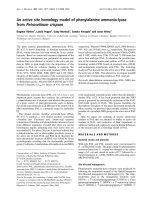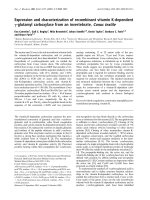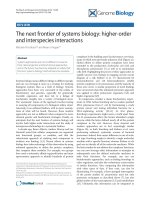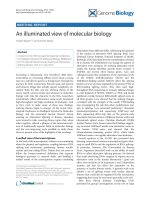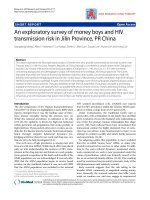Báo cáo y học: "An illuminated view of molecular biology" pps
Bạn đang xem bản rút gọn của tài liệu. Xem và tải ngay bản đầy đủ của tài liệu tại đây (230.01 KB, 3 trang )
Everything is Illuminated, Liev Schreiber’s 2005 direc-
torial debut, is a charming offbeat movie about a young
man on a self-driven quest in a foreign land. rough his
journey, he finds connections between past and present
and between things that initially appear completely un-
related. Both the title and the unifying theme of the
movie match current trends and advances in molecular
biology well. Like the character in the film, researchers
meticulously collect information using newly developed
high-throughput and high-resolution technologies. And
as they work to make sense of these new findings,
unifying themes begin to emerge. At the recent Inter-
national Conference on Intelligent Systems for Molecular
Biology and the associated Special Interest Group
meeting on Alternative Splicing in Boston, attendees
were treated to talks covering diverse topics that, when
taken together, offered a glimpse of the inter connected-
ness of traditionally separate fields in molecular biology
and the ever-improving tools available to study them.
Here we present a few of the highlights of the meetings.
A unied view of the transcriptome
At the level of the transcriptome, evidence is accumu lating
about the physical and regulatory coupling between RNA
splicing and nucleosome positioning, histone modifi-
cations and non-coding RNAs. Nature does not seem to
follow the human-contrived definitions that separate
biological processes or research fields, and building a
unified model of the transcriptome requires combining
information from different fields. Addressing the question
of the control of alternative RNA splicing, Reini Luco
(National Cancer Institute, National Institutes of Health,
Bethesda, USA) described how the trimethy lation of lysine
36 on histone H3 (H3K36me3) can change the pattern of
alternative exon inclusion. By studying alternative exons
within the human fibroblast growth factor receptor 2
(FGFR2) and several other human genes, Luco and
colleagues found that modulation of the expression levels
of the H3K36 methyltransferase SETD2 and the
H3K36me3-binding protein MRG15 affect the splicing
patterns of a set of exons regulated by the protein PTB, an
RNA-binding splicing factor. ey then used high-
throughput RNA sequencing to measure splicing changes
in cells depleted of SETD2, MRG15 or PTB, and found
significant overlap between differentially spliced exons in
all three groups. Luco showed that the splicing changes
correlated with the strength of the nearby PTB-binding
sites. Investigating the role that other modifi cations may
play in splicing, Luco presented preliminary chromatin
immunoprecipitation and sequencing (ChIP-seq) and
RNA sequencing (RNA-seq) data on the genome-wide
asso ciation between dozens of different histone marks and
alternatively spliced exons. Christian Muchardt (CNRS
Institut Pasteur, Paris, France) described findings suggest-
ing increased H3K9me3 marks near alternative exons in
the human CD44 gene, and showed that the
chromodomain-containing protein HP1γ, which binds
H3K9me3 marks, can regulate alter native exon inclusion.
Several speakers at the AS-SIG also presented data
showing connections between transcriptional gene silen-
cing by small RNAs and the regulation of RNA splicing.
In particular, Mariano Alló (Universidad de Buenos
Aires, Argentina) described work on the ability of small
RNAs to affect alternative splicing patterns. He showed
that small interfering RNAs targeted to regions near an
alternative exon in the human fibronectin 1 gene can
affect exon inclusion in an Argonaute 1 and 2-dependent
manner, and that the effect also depended on the
presence of nearby histone marks. A genome-wide scan
yielded a set of splicing events with similar adjacent
features that could also be regulated by this mechanism,
suggesting that it may be used more generally in the cell.
John Rinn (Broad Institute, Cambridge, USA)
presented his group’s investigations on the role of large
Abstract
A report on the 18th Annual International Conference
on Intelligent Systems for Molecular Biology (ISMB) and
the 7th Special Interest Group meeting on Alternative
Splicing, Boston, USA, 9-13 July 2010.
© 2010 BioMed Central Ltd
An illuminated view of molecular biology
Yoseph Barash
1,2
* and Xinchen Wang
2
M E E T I N G R E P O RT
*Correspondence:
1
Biomedical Engineering, Department of Electrical and Computer Engineering,
University of Toronto, 10 King’s College Road, Toronto M5S 3G4, Canada
2
Banting and Best Department of Medical Research and Department of Molecular
Genetics, Donnelly Centre, University of Toronto, 160 College Street, Toronto
M5S3E1, Canada
Barash and Wang Genome Biology 2010, 11:307
/>© 2010 BioMed Central Ltd
intergenic non-coding RNAs (lincRNAs). A genome-
wide screen in mouse identifying potentially non-coding
loci enriched with transcriptionally active histone modi-
fi cations led to the discovery of several new lincRNAs.
Using a guilt-by-association technique to ascribe
potential functions, Rinn and colleagues focused on a
lincRNA upstream of the p21 gene that was induced by
p53, was necessary for apoptosis, and could act as a
global repressor of gene expression. In regard to the
regulatory mechanism, this lincRNA was found to be
bound to a highly conserved region in a specific hetero-
geneous nuclear ribonucleoprotein.
In a highlight talk, Christopher Burge (Massachusetts
Institute of Technology, Cambridge, USA) set a target for
the alternative splicing field to further develop compu ta-
tional tools that can combine data from high-resolution,
high-throughput technologies to build predictive models
for the transcriptome, and he described new tech no-
logical advances that will facilitate these predictive
models. Earlier, at the AS-SIG, YB presented work by the
authors of this report on the tissue-regulated splicing
code, which was mentioned by Burge during his talk. He
focused on a new technology currently being developed
in his lab that uses Illumina high-throughput sequencing
technology to quantitatively assess the DNA-binding
affinity of transcription factors. Burge discussed current
efforts to extend this approach for RNA-binding proteins
and illustrated its usefulness by describing insights
gained into the binding affinity of the yeast transcription
factor GCN4.
Making sense of high-throughput data
As experiments using the new high-throughput tech-
nologies generate data at an increasingly rapid rate,
computational biologists are developing algorithms that
can accurately extract information from these data.
Specifically, the analysis of sequencing data still poses
many challenges. Xiaoyu Chen (University of Washing-
ton, Seattle, USA) described a dynamic Bayesian network
model aimed at identifying transcription-factor-binding
sites in yeast DNA from genomic footprinting experi-
ments involving DNase I digestion of chromatin followed
by high-throughput sequencing. Jared Simpson (Wellcome
Trust Sanger Institute, Hinxton, UK) described work to
construct a tool that can assemble a genome from short
reads and can handle genomes up to several gigabases in
size, such as that of human. Unlike current commonly
used algorithms that utilize de Bruijn graphs, the new
method efficiently constructs a string graph from a set of
reads, an approach particularly well suited for the
assembly of mixed-length read data. Simpson described
hurdles still to be overcome in constructing a genome
assembler, such as the need to accommodate for possible
sequencing errors in the short reads.
Many high-throughput technologies produce data that
are difficult to interpret directly with the human eye.
Consequently, another area that received much attention
was the visualization of biological datasets. Gary Bader
(University of Toronto, Ontario, Canada) presented new
plug-ins for the Cytoscape software commonly used for
visualizing molecular interaction networks that will help
perform enrichment analysis of sets of nodes in large
networks. Lincoln Stein (Ontario Institute for Cancer
Research, Toronto, Canada) presented new features of
Reactome, a manually curated database for biological
pathways, with a web interface that lets users perform
queries and searches. He also described a Reactome
standalone plug-in for Cytoscape that enables users to
integrate and visualize Reactome data with data from
other sources.
There’s plenty of room at the bottom
e study of molecular biology at increasingly fine
resolution was another popular theme. Jonathan Widom
(Northwestern University, Evanston, USA) described the
confirmation of previous studies of nucleosome-binding
preferences and locations in yeast, but with new data at
single-nucleotide resolution. Eran Segal (Weizmann
Institute, Rehovot, Israel) described an experimental set-
up to investigate, at much higher resolution than before,
the regulatory effect of poly(A) tracts near transcription
factor binding sites in yeast promoter regions. Revisiting
a model suggested by Iyer and Struhl in 1995, in which
poly(A) tracts serve to deplete promoters of repressive
nucleosomes, Segal and his colleagues can now quantify
the effect on gene expression of parameters such as the
poly(A) tract length, the proportion of adenine nucleo-
tides, and the distance from the transcription factor
binding sites. ey showed that there is a trade-off
between the length of the poly(A) tract and the propor-
tion of adenine nucleotides in it, and that the influence of
the tract falls steadily with distance from the transcrip-
tion factor binding site, until a distance of 200 bases,
where a local peak is reached. e location of the peak
determined experimentally in this way does not, however,
match well with current computational models. An
interesting question still to be answered is whether
poly(A) tract boundaries serve to fine-tune the expression
levels of adjacent genes.
Jean Beggs (University of Edinburgh, UK) described the
use of RiboSys reporters to enable her group to monitor
cell number, DNA yield, RNA yield, reverse transcription
efficiency, quantitative PCR efficiency and RNA copy
number per cell (using single-molecule FISH) in yeast at
30-second intervals. Using this system, she and her
colleagues identified a 30-second pause in the progress of
the RNA polymerase II (Pol II) complex when splicing is
occurring in yeast RNAs. ey have also identified what
Barash and Wang Genome Biology 2010, 11:307
/>Page 2 of 3
appears to be a novel surveillance mechanism, in which
phosphorylation of the Pol II complex at Ser5 is used to
first pause it and then at Ser2 to resume its progress, and
involving several proteins such as Ioc2 and Ioc4
(members of the Isw1 chromatin-remodeling complex).
As Beggs pointed out, one could only observe this
mechanism with a high-resolution system such as theirs,
and only when the yeast cell population was well
synchronized.
Computational approaches for studying disease
Opening the ISMB main conference, Steven Brenner
(University of California, Berkeley, USA), told an inspir-
ing story about a lab member whose successful treatment
for lung cancer was a result of a better molecular
understanding of a specific cancer mutation she carried.
e interest in using computational biology to better
understand the etiology and pathology of cancer and
other diseases was exemplified by the fact that more than
half of the timeslots at this year’s conference featured at
least one talk on studying human disease with compu-
tational methods. In a prize-winning talk, Peter Van Loo
(University of Leuven, Belgium) presented an algorithm
called ASCAT (Allele-Specific Copy number Analysis of
Tumors), which takes signal intensities from whole-
genome single-nucleotide polymorphism array data to
estimate the proportion of tumor cells and tumor ploidy
in a heterogeneous sample. On a genome-wide scale,
ASCAT can then identify cancer-associated copy-
number changes for individual loci.
In relation to pharmacogenomics, Rachel Karchin
(Johns Hopkins University, Baltimore, USA) described
computational approaches for distinguishing driver
muta tions, which can identify genes that may be promis-
ing drug targets, from passenger mutations in the genetic
landscape of a tumor. She discussed a tool called CHASM
(Cancer-specific High-throughput Annotation of Somatic
Mutations) developed in her lab, which uses a machine-
learning approach to classify missense mutations into
these two categories on the basis of properties of the
mutated amino acids that may affect the translated
protein. David Altshuler (Harvard Medical School,
Cambridge, USA) supplied a word of caution during his
keynote talk about the value of disease prediction. Giving
the example of the detection of prostate cancer using
prostate-specific antigen, Altshuler emphasized that
being able to predict outcomes does not automatically
translate to being able to help patients. In this case, the
corresponding treatment did not increase the patients’
life expectancy, but did saddle many individuals with
debilitating side effects.
e themes reviewed here reflect how the field of
computational biology is constantly shifting, adapting to
the new high-resolution and high-throughput tech-
nologies that are being developed, as well as to the new
scientific questions these technologies allow us to ask.
Data processing and visualization can therefore be
expected as central themes at ISMB conferences in the
future, but we should also expect to see work exploring
the unified view of the transcriptome and its complexity,
with connections to focused disease studies.
Acknowledgements
We thank Ben Blencowe and John Calarco for providing helpful feedback.
Published: 26 August 2010
doi:10.1186/gb-2010-11-8-307
Cite this article as: Barash Y, Wang X: An illuminated view of molecular
biology. Genome Biology 2010, 11:307.
Barash and Wang Genome Biology 2010, 11:307
/>Page 3 of 3


